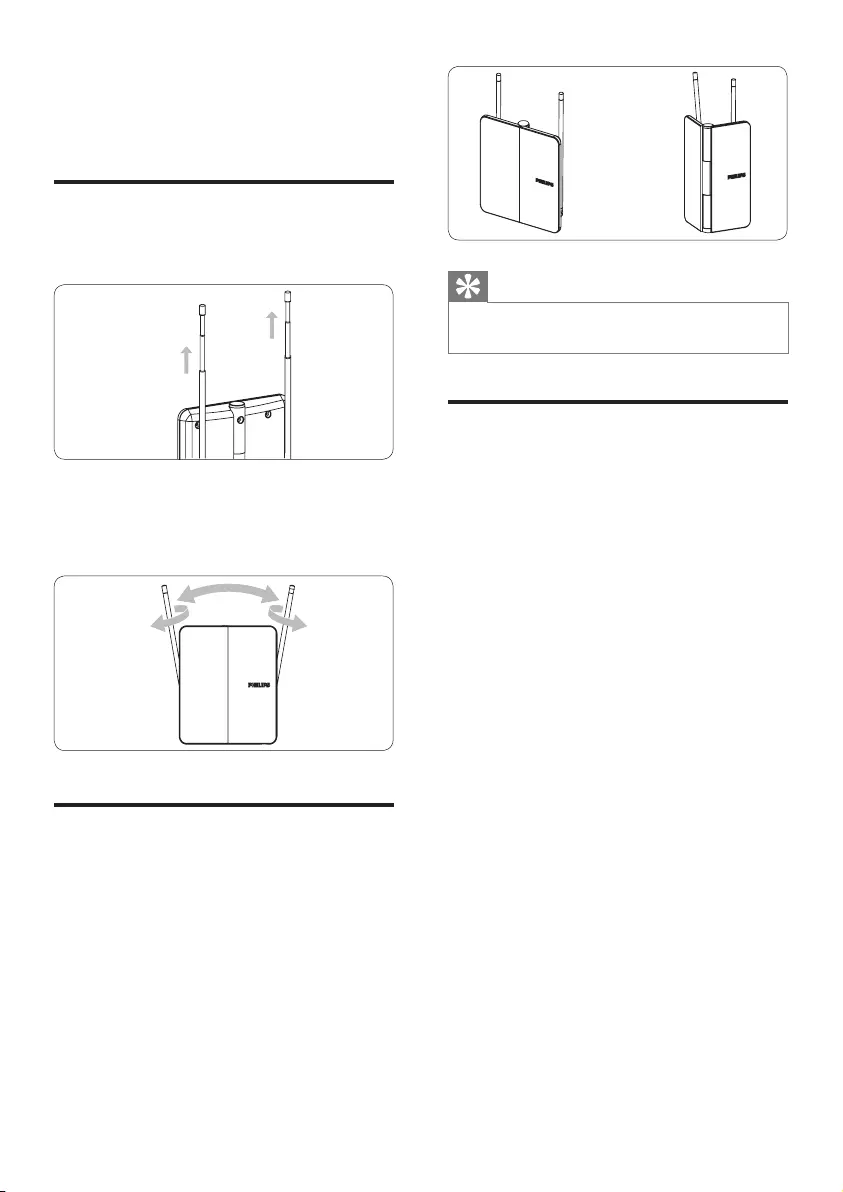Table of Contents
- Contents
- 1 Important
- 2 Your SDV1225T/27
- 3 Get started
- Determine the signal strength
- Connect to the TV
- 4 Set up SDV1225T/27
- 5 Frequently asked questions
- 6 Warranty and service
- Contenido
- 1 Importante
- 2 La SDV1225T/27
- 3 Comienzo
- 4 Configuración del SDV1225T/27
- 5 Preguntas más frecuentes
- 6 Garantía y servicio
- 7 Glosario
- Table des matières
- 1 Important
- 2 Votre SDV1225T/27
- 3 Mise en route
- 4 Configuration du SDV1225T/27
- 5 Foire aux questions
- 6 Garantie et réparation
- 7 Glossaire
Philips SDV1225T/27 User Manual
Displayed below is the user manual for SDV1225T/27 by Philips which is a product in the Television Antennas category. This manual has pages.
Related Manuals


3
English
EN
Contents
1 Important 4
Safety 4
Notice for USA 4
Notice for Canada 4
Recycling 4
2 Your SDV1225T/27 6
Overview 6
3 Get started 7
Installation 7
4 Set up SDV1225T/27 8
For VHF reception 8
For UHF reception 8
Set up a digital tuner with this
antenna 8
5 Frequently asked questions 9
6 Warranty and service 9
7 Glossary 10

4
Increase the separation between •
equipment and receiver.
Connect the equipment into an outlet on •
a circuit different from that to which the
receiver is connected.
Consult the dealer or an experienced •
radio/TV technician for help.
All other devices shall bear the following
statement in a conspicuous location on the
device:
This device complies with part 15 of the FCC
Rules. Operation is subject to the following
two conditions: (1) This device may not cause
harmful interference, and (2) this device must
accept any interference received, including
interference that may cause undesired
operation.
Notice for Canada
Class B Clause
This digital apparatus does not exceed the Class
B limits for radio noise emissions from digital
apparatus as set out in the Radio Interference
Regulations of the Canadian Department of
Communications.
This Class B digital apparatus complies with
Canadian ICES-003.
Recycling
Your product is designed and manufactured
with high quality materials and components,
which can be recycled and reused.
Never dispose of your product with other
household waste. Please inform yourself about
the local rules on the separate collection of
electrical and electronic products. The correct
disposal of your old product helps prevent
1 Important
Safety
This manual contains important information
about the Philips indoor television antenna.
Read it carefully before you start the installation
and setup.
The product shall not be exposed to •
dripping or splashing and that no objects
lledwithliquids,suchasvases,shallbe
placed on the product.
To completely disconnect the power •
input, the mains plug of the product shall
be disconnected from the mains.
Where the mains plug is used as the •
disconnect device, the disconnect device
shall remain readily operable.
Nonakedamesources,suchaslighted•
candles, should be placed on the product.
Notice for USA
This equipment has been tested and found
to comply with the limits for a Class B digital
device, pursuant to part 15 of the FCC Rules.
These limits are designed to provide reasonable
protection against harmful interference in a
residential installation. This equipment generates,
uses and can radiate radio frequency energy
and, if not installed and used in accordance
with the instruction manual, may cause harmful
interference to radio communications.
However, there is no guarantee that
interference will not occur in a particular
installation. If this equipment does cause harmful
interference to radio or television reception,
which can be determined by turning the
equipment off and on, the user is encouraged
to try to correct the interference by one or
more of the following measures:
Relocate the receiving antenna.•
EN

5
potentially negative consequences on the
environment and human health.
The packaging of this product is intended to
be recycled. Contact your local authorities for
information about how to recycle the packaging.
When this logo is attached to a product, it
meansanancialcontributionhasbeenpaidto
the associated national recovery and recycling
system.
© 2010 Koninklijke Philips Electronics N.V. All
rights reserved. Reproduction in whole or in
part is prohibited without the written consent
of the copyright owner. Trademarks are the
property of Koninklijke Philips Electronics N.V.
or their respective owners.
English
EN

6
1 VHF antenna
2 UHF antenna
3 Out to TV connection
4 Supporting plate
2 Your
SDV1225T/27
Congratulations on your purchase and welcome
to Philips!
TofullybenetfromthesupportthatPhilips
offers, register your product at www.philips.
com/welcome.
Overview
EN

7
2 To make the antenna stand straight, open
the supporting plate at the back of the
antenna (the maximum angle of opening
is 120 degrees).
3 Get started
To ensure the antenna to work properly, read
the user manual of your television before you
start. Set the television so that it receives the
signal from an ANTENNA instead of CABLE or
SATELLITE.
Installation
Determine the signal strength
Before Installation, determine the best
location for optimum reception. It is important
for the antenna to have an unobstructed path
to the transmitter. For best results, ensure the
antenna faces the location of the transmitter.
Note
Choose a location near a window which gives •the antenna a clear view of the transmitter.
Note
Place the antenna away from the metal surface •to avoid interference.
Connect to the TV
1 Connect the coaxial cable to the TV.
TV
ANT.
English
EN

8
Tip
For best reception, point the antenna in the •direction of the transmitter.
Set up a digital tuner with this
antenna
You can install available channels with the digital
TV tuner. This automatic process is part of the
setup of the tuner. Ensure the antenna has
set up properly before the tuner can receive
viewable channels.
There are two ways to connect the antenna to
the TV:
Connect the antenna to a digital tuner. •
If the signal strength is good enough, the
channels can be memorized in the tuner
automatically .
Connect the antenna directly to the TV. •
Tunetotheanaloguechannelsandnd
the best antenna location. Then re-
connect the antenna to the digital tuner.
Ensure the signal strength is good enough
before you install the channels with the
tuner.
-or-
4 Set up
SDV1225T/27
For VHF reception
1 Extend the telescopic dipoles to the
longest possible length.
2 Turn the TV to the desired channel. Move
the dipoles in different directions up and
down until the reception is achieved.
For UHF reception
1 Turn the TV to the desired channel.
PointtheUHFreectortowardsthe
transmitter until reception is achieved.
EN

9
6 Warranty and
service
Warranty information can be found at: www.
philips.com/welcome
For technical support, send us an email
with the model number of the product
and a detailed description of your problem
to:accessorysupport@philips.com
5 Frequently
asked questions
Can this antenna work with Analog
transmissions?
Yes, this antenna can receive analog television
broadcasts in the UHF and VHF bandwidths.
Can this antenna receive digital or work with
HD-ATSC broadcasts?
Yes, this antenna is designed to receive digital
ATSC and HDTV broadcasts in the UHF &
VHF bandwidths.
Where should I place the antenna in order to
get the best reception possible?
Choose a location near a window which gives
the antenna a clear view of the transmitter.
Tip
For best reception, place the antenna away •from the metal surface to avoid interference.
Can I set up this antenna with a digital tuner?
Yes, this antenna can be set up with a digital
tuner (see the section on “Set up a digital
tuner with this antenna”).
English
EN

10
V
VHF (Very high frequency)
In radio or TV broadcasting: it is the frequency
range of electromagnetic waves which lies
between 30 MHz and 300 MHz.
7 Glossary
A
Antenna
A device, such as a rod or wire, which picks up
a received radio frequency signal or radiates a
transmitted RF signal.
C
Coaxial
A single copper conductor, surrounded with
a layer of insulation, covered by a surrounding
coppershieldandnally,aninsulatingjacket.
An unbalanced transmission line with constant
impedance. In audio, this type is commonly
used for low level, line signals terminated in
RCA connectors.
D
DVB (Digital Video Broadcasting)
DVB is a suite of internationally accepted open
standards for digital television.
H
HDTV (High-Denition Television)
It is a digital television broadcasting system
with higher resolution than traditional
televisionsystems(standard-denitionTV,
or SDTV). HDTV is digitally broadcast;
the earliest implementations used analog
broadcasting, but today digital television
(DTV) signals are used, requiring less
bandwidth due to digital video compression.
U
UHF (Ultra high frequency)
In radio or TV broadcasting: it is the frequency
range of electromagnetic waves which lies
between 300 MHz and 3 GHz (3000 MHz).
EN


© 2010 Koninklijke Philips Electronics N.V.
All rights reserved. DFU_SDV1225T_27_V1.0
